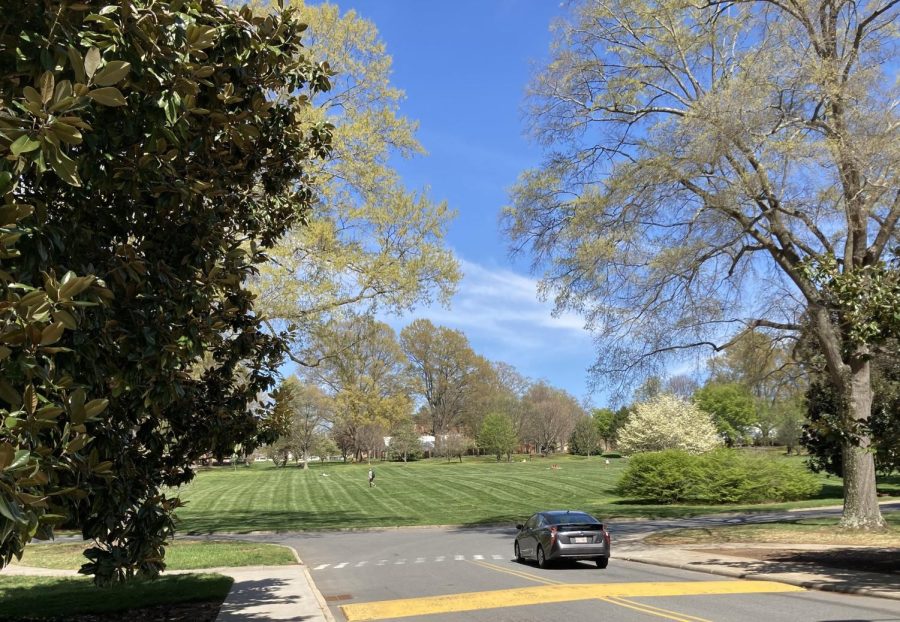University should not build road through Davis Field
The benefits of building a road do not outweigh the advantages that an open greenspace provides to students
Wake Forest Road currently routes around Davis Field.
April 7, 2022
When I was moving into my dormitory last August, I had botched some directions to Babcock Residence Hall. My dad, who was nearing the tail end of an eight-hour drive, was slightly agitated. My mistake was entering campus from the opposite side we had intended to enter from. We rode on the segment of Wake Forest Road that hugs Davis Field — the largest green space on our campus.
My dad decelerated as my entire family stared at eager freshmen tossing frisbees, flinging footballs and starting conversations on that field — that first day of college conversations and activities that we thought determined our time at school. Davis Field helped spur those first steps, while also providing green space, trees and shade which create a naturally gorgeous place on campus.
Next year, Wake Forest plans on paving a road straight through Davis Field, a vertical one that will slash through this idyllic place.
A previous Old Gold & Black news article written by staff writer Jackie Thacher communicates the benefits that the university foresees will come with the construction of the road. These benefits include traffic decongestion around the ZSR Library and a more efficient entrance into Wake Forest’s main hub.
However, bisecting Davis Field is not worth the benefits it could provide. To be fair, not many perks would encourage me to support any development that means less green on campus. Less grass and fewer trees is all I take away from Wake Forest’s press release on the subject. I’m a very nuanced reader, I know.
As someone who took his college tours during the COVID-19 pandemic, I did not get to venture into many buildings of any universities that I visited. Understandably, I was restricted to strolling around campus squares and outdoor plazas. The most astute and genuine compliment I could give to a campus was “mhm, lots of green space here. Love that for them.”
We certainly don’t lack green space on campus. Most faculty and students — myself included — seem to believe that we are lucky to have such a gorgeous campus. Both Manchester and Hearn Plazas are a pleasure to walk through on sunny days. You can do some of the things you can do on Davis Field at these locations, whether that be tossing a football for fun or reading for leisure. Davis Field is not the only available place to engage in recreational activities with trees around you.
However, Davis Field is unique in that it’s the only place that offers a space to relax away from the traffic of students walking to and from class. It’s the singular place to hold large events hosted by a variety of Wake Forest’s phenomenal organizations. It’s home to three holes of a beloved frisbee golf course. While I rest on a hammock pitched on Davis Field, I can forget about the jackhammer going to work on a new building 50 feet away from my dorm. When I go to Manchester or Hearn, this construction is still well within earshot.
Cars traversing Davis Field disturb a tranquil haven on campus, a haven that people look to for a mental health break, where people can hold picnics and walk dogs. The paving of the street itself will uproot trees and generate roadside litter. While I can’t speak from an uber-knowledgeable perspective regarding environmental science, I view this new road as a project that will sully an incredible spot on our campus.
However, Aidan Norris, another first-year student at Wake Forest who also opposes the construction of this road actually does have experience researching the ways humans impact the environment. Norris has volunteered with environmental engineering projects in the past and is currently involved with sustainability groups on campus. Two weeks ago, Norris began sharing an online petition that calls to halt the road’s construction. Since then, it has garnered an impressive 518 signatures.
“I disagree with the decision to build the road because Davis Field is one of my favorite spots on campus,” Norris said when asked about his disapproval of the road. “It was the first thing that impressed me when I visited campus and is a place that has time and time again reminded me of the natural beauty of our campus.”
Norris continued: “Some responses I’ve gotten from other students mention the [beneficial] mental health effects of having such a beautiful space on campus to relax and unwind in. This would be diminished by the presence of cars and traffic through the field.”
At least 516 individuals who attend Wake Forest or are somehow related to the students agree with the stance that Norris and I share. I should mention that Norris was the first person to alert me of the news of the road officially being approved. I believe his passionate response to it stems from both a genuine love for nature and a burning desire to give students a voice.
So, why not just a walking path, Wake Forest? While this may not address the traffic problem that supposedly exists, I am a fan of the idea. I know that the people affiliated with this school who signed Norris’ petition would likely endorse such a compromise as well.















